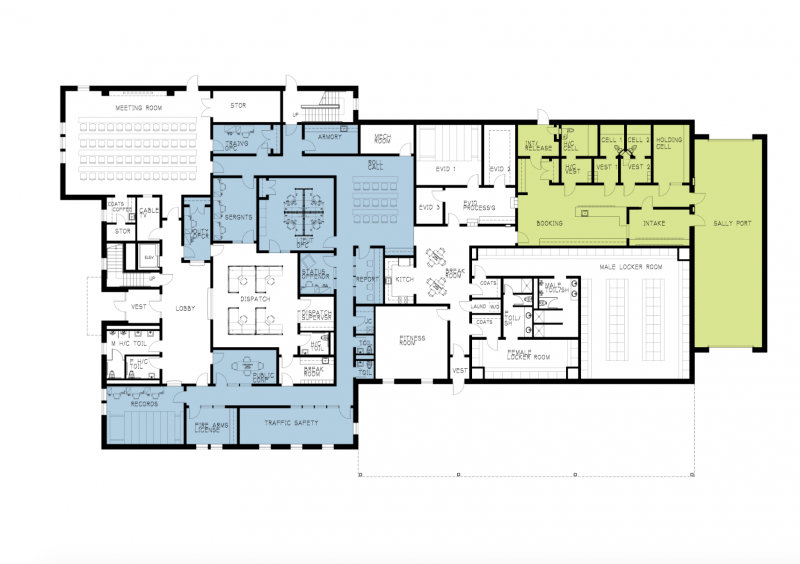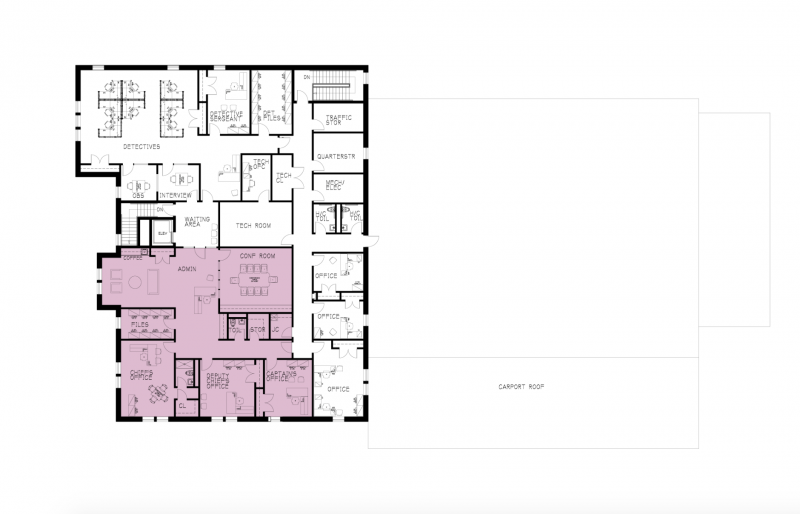Police chief, advisory board present station updates
The $13.6 million proposed design of the new Dartmouth Police station features a 60-person meeting room accessible to the public, a "sally port" for transferring prisoners, and 3,500 square feet of open space for future growth.
Project Manager Richard Pomroy and Architect Greg Carell presented the design to the Select Board on February 6, along with the police chief and the advisory group charged with guiding the project.
The 21,800 square-foot Tucker Road building proposed at the site of the current Gidley School is comparable in size to the current Russells Mills police station, said Police Chief Bob Szala. However, the current building has "five times as much corridors and wasted space," Szala explained.
The building — which will replace the Gidley School, slated for demolition in February or March — needed to be state-of-the-art without being frivolous, add to the historic charm of town, and represent the professionalism of the police department, said Carell.
The facade is a "softer tone," looking half like a police station and half like a school, Szala said before the presentation, adding that the goal was to blend it into the residential neighborhood.
Select Board members approved of the building's exterior.
"I think the building is very attractive, and I can see right away you folks were trying to incorporate the Gidley School look," said Select Board member Frank Gracie.
Key features include a meeting room that will be accessible to the public without allowing people access to the secured parts of the station, said officials. Additionally, a sally port — which allows for vehicles and ambulances to drive into a tunnel with doors that lock behind it so that prisoners can be safely transferred into the station — would complete the building.
The design also alleviates various logistical problems of its Russells Mills Road predecessor, which was closed in 2014 after bacteria in the hot water heating system made an officer sick.
"We didn't have enough lockers," the chief noted, adding that the design includes 80 men's lockers and 15 women's lockers. "Some people had to use corners of the room."
Behind the facility, the designers included a small fuel station. Select Board member John Haran considered the above-ground tanks a potential liability, but member Shawn McDonald said the tanks are more logical than asking officers to fuel at the nearby Department of Public Works station.
“I think the facility behind the police station is the wiser choice,” McDonald said, noting that the police station runs 24/7, 365 days a year, while the DPW typically runs Monday through Friday, 7 a.m. to 4 p.m.
The tanks will only contain gas, not diesel like DPW stations do, officials said. There will also be safety precautions, including spill alarms and containers.
Additionally, a carport — which is just a roof, explained Carell — would keep snow and rain off of patrol vehicles so that they are ready for immediate use.
Carell explained that the design is still flexible.
"These are all working documents. We have a building, and we have an estimate. We can incorporate further changes the chief [or the town] may want to make," he said.
Chief Szala is simply excited to have an appropriate home base for his officers. He explained that since the Russells Mills station closed, the 91-person department has functioned out of 7,200 square feet of modular units, and five trailers and two sheds that total an additional 1,176 square feet behind the closed station.
Currently, the sheds house the telephone system and radio server, while the trailers house firearms, evidence, and records, said Szala.
"It's not the way to do business," he said. "Anyone could cut us off," he added, explaining that the aforementioned communications are currently housed in three locations. The proposed design has all the technology securely located on the second floor of the building.
Current cost estimates for the project reflect a five- to 10-percent contingency, explained Szala. He expects the project to start by 2018, and the 14- to 16-month project should yield an operational station by January 1, 2020 at the latest, he said. If the project is delayed, the town could have to deal with increasing construction costs, he added.
A lingering question about the fate of the school's athletic fields was answered. They'll be taken out of service.
"Once construction starts, the fields would have to be off limits," Pomroy explained. "The thought behind it is that the back of the property is the secure area for the department."
The advisory board plans to add further details, along with demolition estimates for the Russells Mills station and tower deconstruction. It plans to have a final study and complete budget by February 22.















